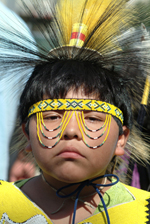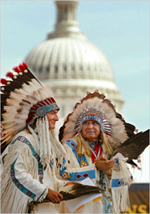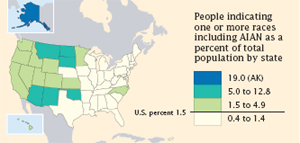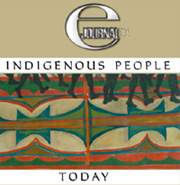 |
Fertig für die Festlichkeiten anläßlich der Eröffnung des National Museum of the American Indian.
(Photos von Lloyd Wolf für das U.S. Census Bureau) |
Die ersten Amerikanischen "Einwanderer" vor mehr als 20.000 Jahren waren interkontinentale Wanderer : Jäger und ihre Familien, die den Herden von Asien nach Amerika folgten als noch eine Landbrücke existierte dort wo heute die Bering Straße die beiden Kontinente trennt. Als Christoph Columbus 1492 die Neue Welt „entdeckte", lebten ungefähr 1,5 Millionen Indianer auf dem heutigen Gebiet der kontinentalen Vereinigten Staaten, obwohl die Schätzungen über diese Zahl weit auseinander gehen. Columbus verwechselte die Küste von San Salvador auf den Bahamas, wo er landete, mit Indien und nannte die Eingeborenen "Indianer."
In den nächsten 200 Jahren kamen Menschen aus verschiedenen Europäischen Ländern auf Columbus' Spuren über den Atlantik um Amerika zu erforschen und um Handelsposten und Kolonien zu errichten. Die Eingeborenen litten sehr unter dem Eindringen der Europäer. Das Land ging durch Verträge sowie durch Krieg und Gewalt, von den Indianer in die Hände der Europäer - und später der Amerikaner – über; dabei wurden die Indianer immer weiter von den nach Westen ziehenden Neuankömmlingen verdrängt. Die Regierungslösung für das „Indianerproblem" bestand im 19. Jahrhundert darin, die Indianer in bestimmte Gebiete, die Reservate, zu zwingen. Einige Stämme kämpften um ihr angestammtes Territorium nicht aufgeben zu müssen.
In vielen Fällen handelte es sich bei den Reservaten um minderwertiges Land, und die Indianer wurden abhängig von Unterhaltszahlungen der Regierung. Auch heute gibt es noch Armut und Arbeitslosigkeit unter den Indianern. Durch die Territorialkriege sowie durch Krankheiten, die aus der alten Welt eingeschleppt wurden und gegen die die Indianer nicht immun waren, wurde ihre Zahl 1920 auf den niedrigsten Stand der Geschichte, nämlich 350.000, dezimiert. Einige Indianerstämme verschwanden ganz: wie zum Beispiel die Mandans aus North Dakota, die Meriwether Lewis und William Clark 1804 - 06 geholfen hatten Amerikas unbesiedelte Wildnis im Nordwesten zu erforschen. Andere Stämme verloren ihre eigene Sprache und Kultur. Nichtsdestoweniger haben die Indianer Nordamerikas überlebt. Heute leben 4.5 Millionen Indianer und Ureinwohner Alaskas in den Vereinigten Staaten (das entspricht etwa 1.5 % der Gesamtbevölkerung), und nur etwa ein Drittel der indianischen Gesamtbevölkerung lebt in Reservationen, bzw. in unmittelbarer Nachbarschaft.
Zahllose Amerikanische Ortsnamen gehen auf Indianische Worte zurück, unter anderem die Namen der Bundesstaaten Massachusetts, Ohio, Michigan, Mississippi, und Idaho. Indianer lehrten die Europäer Pflanzen anzubauen, die jetzt in der ganzen Welt als landwirtschaftliche Erzeugnisse geschätzt werden: Mais, Tomaten, Kartoffeln, Tabak. Kanus, Schneeschuhe und Moccasins zählen zu den vielen Indianischen Erfindungen.
|
|
Indigenous
People in the 21st Century
Wilma Mankiller. eJournal, June 2009.
Being an indigenous person in modern times means balancing revered traditions,
culture, and languages with the demands of a world dominated by technology.
Mankiller is former chief of the Cherokee Nation.
Living
Traditions of Native America
Gabrielle Tayac. eJournal, June 2009
Coming to terms with a rich and ancient tradition, years of struggle
and discrimination, and life in modern times, Native peoples must juggle
the valuable old with the new. Historian Tayac is of Piscataway descent.
U.S.
Honors Contributions of American Indians, Alaska Natives
America.gov, November 3, 2008.
Each November, National American Indian Heritage Month pays tribute
to the legacy of the American Indians and Alaska Natives — the
first Americans — and celebrates their enduring contributions
to the history and culture of the United States.
Today,
there are nearly 5 million American Indians and Alaska Natives in the
United States, or 1.6 percent of the total population, and this is expected
to jump to 8.6 million, or 2 percent of the population, by 2050.
Most
American Indians live in metropolitan areas and not on the 227,000 square
kilometers of land held in trust for reservations. The states with the
highest percentage of American Indians and Alaska Natives are Alaska
(18 percent of its population), Oklahoma (11 percent) and New Mexico
(10 percent).
There
are 562 federally recognized Indian tribes in the United States. The
largest, by far, are the Cherokee and Navajo nations, according to the
2000 U.S. census....
Navajo
Textbook Aims to Preserve Language, Culture
New Mexico is first state to approve Native American language text.
By Jeffrey Thomas. America.gov, August 5, 2008.
In many countries with indigenous populations, how these groups adapt
to the modern world while protecting their own cultures is an important
question. It therefore was reported widely when New Mexico in July became
the first U.S. state to approve a textbook that teaches a Native American
language -- Diné Bizaad Bínáhoo'aah or Rediscovering
the Navajo Language. Native North American languages are spoken by about
380,000 Americans, according to the 2000 census. The Navajo Nation numbers
almost 300,000 people, of whom about 178,000 speak the Navajo language,
making it the most widely spoken Native American language....
American Indians Seek Greater Understanding, Recognition
By Jeffrey Thomas, America.gov, October 18, 2007.
“Maybe you should just tell them that we still exist,” an American Indian told the moderator of a focus group during a recent study that not only has highlighted continuing misconceptions about American Indians, but also has revealed the sympathy with which many Americans view Indians’ history and desire to learn more about their past and present...
National Powwow Honors American Indian Cultural Traditions
By Lauren Monsen, America.gov, August 14, 2007.
Since the late 19th century, powwows have been a significant social and cultural force in the lives of the indigenous people of North America. Bringing together American Indians from different tribes to dance, sing and share traditions, these social events are held throughout the United States from March to September, but the largest on the East Coast is the National Powwow, a biennial event in Washington that attracts members of some 250 tribal nations from the United States and Canada...
 |
Senator Ben Nighthorse Campbell, right, a Northern Cheyenne Indian, applauds W. Richard West Jr., a Southern Cheyenne, who is the director of the new National Museum of the American Indian, at the dedication ceremonies for the museum on the National Mall in Washington, September 21, 2004. (© AP Images) |
United States Respects Indian Tribes' Right to Self-Determination
Indian tribes retain unique sovereign status as "domestic dependent nations". By Peggy B. Hu and Jeffrey Thomas. America. gov, November 6, 2006.
Many people are puzzled when they hear the U.S. president use such phrases as “government-to-government basis with tribal governments,” “tribal sovereignty” or “self-determination” for American Indians. Isn’t the United States “one nation ... indivisible," as the Pledge of Allegiance says?
The answer is more interesting than a simple “yes” or “no.” According to the U.S. Department of Justice's Office of Tribal Justice, American Indian tribes are considered "domestic dependent nations" within the United States. As such, they retain sovereign powers over their members and territory except where such powers specifically have been modified by U.S. law. American Indians are more than members of a racial minority group in the United States; they are indigenous people of the Americas with a status akin to dual citizenship.
Laws Reflect Changing Status of American Indians in U.S. History. America.gov, November 6, 2006
The history of U.S. legislation regarding American Indians reveals changing societal attitudes on their status -- from members of fully sovereign nations, to dependents of the U.S. government, to holders of a quasi dual-citizenship. |

 U.S.
Diplomatic Mission to Germany
/Public Affairs/ Information Resource Centers
U.S.
Diplomatic Mission to Germany
/Public Affairs/ Information Resource Centers



